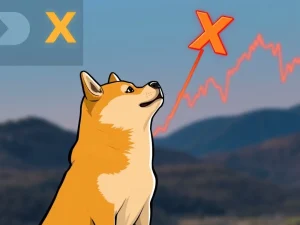Bitcoin Price Plunges as 104% China Tariffs Confirmed: Is a New Low Imminent?

Just when crypto enthusiasts dared to breathe a sigh of relief, Bitcoin’s recent rally hit a wall. Fueled briefly by whispers of tariff pauses, this optimism evaporated faster than morning mist as the White House officially confirmed a staggering 104% tariff hike on Chinese goods, effective April 9th. Now, the big question on everyone’s mind: will this news trigger another significant Bitcoin Price Drop, sending BTC to new lows?
China Tariffs Trigger Bitcoin Price Jitters
The initial bounce of Bitcoin to $81,180 proved short-lived. It was a classic case of market sentiment reacting to misinformation. Fake news about a potential delay in US tariffs sparked a temporary surge, highlighting just how sensitive the crypto market is to global economic policies. However, reality bit hard when the White House confirmed the 104% tariffs against China. This confirmation sent ripples through traditional markets as well, with the S&P 500 struggling to hold onto intraday gains, mirroring the uncertainty gripping the crypto sphere.
Having dipped below the $75,000 mark for the first time since early November 2024, Bitcoin is now navigating precarious territory. Traders are keenly watching a crucial demand zone, hoping it will act as a bulwark against further declines. This zone, described as a “fair value gap,” lies between $77,000 and $73,400. Interestingly, this zone originated during the so-called “Trump pump” back in November 2024, adding historical context to its significance.
| Key Bitcoin Price Levels | Description |
|---|---|
| $81,180 | Peak of the recent relief rally |
| $75,000 | Critical support level recently breached |
| $77,000 – $73,400 | “Fair Value Gap” demand zone |
| $74,000 | March 2024 All-Time High (potential defense line) |
Expert Market Analysis: Will Bitcoin Hold or Fold?
Renowned crypto analyst Michael van de Poppe of MN Capital had previously emphasized the importance of Bitcoin retesting this demand zone before any potential upward trajectory could resume. He stated that this retest was necessary for Bitcoin to gather strength for its next move. Following Bitcoin’s brief flirtation with the $80,000 level, van de Poppe acknowledged the positive momentum but remained cautious, stating, “I don’t know whether we’ll be having another drop or whether we’ve seen it all.” This highlights the inherent uncertainty and volatility currently dominating the Bitcoin Price action.
Fellow analyst Jelle echoed this sentiment, pointing to Bitcoin’s resilience in closing above $79,000 on April 7th, despite plummeting to $74,400 earlier. He contrasted this performance favorably against traditional equities, suggesting underlying strength in Bitcoin despite the external pressures. Jelle’s outlook is one of cautious optimism, “Waiting for the dust to settle – expecting the price to move higher once that happens.”
Long-Term Holders: A Potential BTC Price Drop Catalyst?
Adding another layer of complexity to the market analysis, onchain data from CryptoQuant is raising eyebrows. The focus is on long-term holders (LTHs) – those who have held Bitcoin for over 155 days. Data suggests these LTHs might be preparing to offload their holdings, particularly in the wake of the recent price turbulence. This potential selling pressure could significantly exacerbate any downward trend.
Decoding the Exchange Inflow CDD Metric
The Exchange Inflow Coin Days Destroyed (CDD) metric is crucial here. It measures the volume of Bitcoin flowing into exchanges, weighted by the dormancy period of those coins. A spike in CDD indicates that older coins, held for longer periods, are being moved to exchanges – often a precursor to selling. A significant spike was observed on April 7th, signaling that these older coins are indeed “waking up.” Historically, this has been a bearish indicator for Bitcoin’s price.
- What is Exchange Inflow CDD? A metric tracking Bitcoin moved to exchanges, weighted by how long they were dormant.
- Why is it important? Spikes often precede selling pressure from long-term holders.
- Recent Spike: A notable spike occurred on April 7th, mirroring past bearish signals.
CryptoQuant’s contributor, IT Tech, highlighted in a “Quicktake” blog post the historical correlation between CDD spikes and price drops. For instance, a spike on April 2nd preceded a drop from $88,000 to $81,000. Similarly, a spike on March 27th was followed by a 7% price decline over two days. The analyst now questions, given the April 7th spike, whether Bitcoin’s Price Drop is set to continue as long-term holders potentially prepare to sell again.
Bitcoin: Exchange Inflow CDD. Source: CryptoQuant (Replace with actual chart image)
Will Bitcoin Fall to New Lows? Navigating Market Uncertainty
If historical patterns hold true, Bitcoin could face further selling pressure in the coming days. The March 2024 all-time high near $74,000 stands as the immediate line of defense. Whether this level will hold remains to be seen. The confluence of China Tariffs, potential long-term holder selling, and broader market uncertainty creates a challenging landscape for Bitcoin.
While the short-term outlook appears uncertain, it’s crucial to remember that the crypto market is inherently volatile. External factors like geopolitical tensions and tariff announcements can trigger swift and significant price swings. Investors should approach the market with caution, conduct thorough research, and manage risk effectively. The coming days will be critical in determining whether Bitcoin can weather this storm or succumb to further downside pressure.
Disclaimer: This article is for informational purposes only and should not be considered investment advice. Cryptocurrency investments are highly risky. Conduct your own research before making any investment decisions.
#Bitcoin #Cryptocurrencies #China #BitcoinPrice #Markets #Stocks #WhiteHouse #DonaldTrump #MarketUpdate










